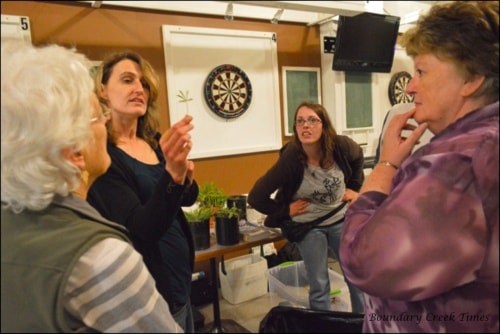The Boundary Invasive Species Society (BIS) has a busy summer ahead of it as the focus of the group expands beyond weeds to include aquatic invasive species.
BIS (until last year known as the Boundary Weed Management Committee) functions to coordinate management efforts of partners and to carry out public information programs and this year a summer student will be employed on education and inventory projects.
The group held their AGM on Wednesday, April 30 at the Greenwood Legion. Along with other business they adopted their five-year strategic plan.
After their AGM and lunch UBCO Professor Dr. Jason Pither gave a presentation on the Russian Olive as an emerging threat to Western Canadian riparian ecosystems. BIS Coordinator Barb Stewart said that while this invasive is not yet known to be in the Kettle River, this watershed is considered a high-risk area. “But up in the Thompson it has just lined the rivers. It affects nutrient cycling in the water bodies it invades.”
Pither and his grad students also gave a summary presentation on work being submitted for publication on invasive hawkweed identification – an invasive that is already here in the Boundary. Stewart said his work on identification is critical for development of bio-controls.
Lisa Tedesko of the Ministry of Forests, Lands, and Natural Resource Operations gave a talk on Aquatic Invasive Species identification and current status.
Stewart then gave an Invasive Plant and Weed Identification Refresher Course.
She said there is a need to build a local knowledge base that can reliably identify aquatic invasive species. “People need to know what to look for,” Stewart said, adding that BIS has received some funding and will hopefully get enough funds to do the entire inventory program to actually determine what aquatic species we even have.
“In Christina Lake there is good information but for the rest of the Boundary there is not. We have approval for a summer student and that individual will be doing an inventory throughout the Boundary.”
They will also be working on educating the public about aquatic species and encouraging people to clean, drain and dry their equipment.
This is an expansion of a program carried out at Christina Lake last year that works to prevent the introduction of mussels. That program will expand to the rest of the Boundary in 2014. “To get people to keep their canoes, kayaks and wading boots clean so they are not spreading fish diseases or aquatic plants we don’t want spread between our water bodies and rivers,” explained Stewart.
Stewart also oversees regional district contractors who do roadside spraying and cautions residents to be aware the crews will be out from the end of May through the summer.
BIS will have an information table at Garden Days at Freeman’s Country Store this Friday, May 9 and at the Grand Forks ATV Club Family Fun Day on Saturday May 10.
Stewart says she hopes to organize a pesticide applicator course in mid-May.
Stewart says the group would like to see more research into bio-control options and, to that end, will work with other invasive species groups to promote the idea of establishing a bio-control research chair in BC. “This would increase research capacity in the province,” she said. “People want more bugs – which is awesome. This is very cool.”
The Okanagan Basin Water Board is now lobbying local governments and other stakeholders asking them to urge the federal government to put border controls in place that would keep invasive mussels out of BC.
Stewart expressed disappointment with the province’s response to the invasive mussel. “The province is really slow about this,” she said. “They know about it, they are concerned about it – they just don’t have any funds for it.”
Idaho has mandatory inspection and huge billboards. Some BC-bound boats that were contaminated have been intercepted there.
Stewart said that any time you see a mussel attached to a boat it is an invasive species, because the native species do not attach to water craft.
The work of the BIS is therefore more important. Other components of their education plan include placing signs at busy river access sites about the threat posed by the mussels and at car washes that explain how to correctly clean boats and equipment.
More information on invasive mussels is online at protectyourwaters.net Aquarium and pond owners are encouraged to educate themselves on the risk of introducing invasive species through ornamental plants that are commonly for sale in the Okanagan.
Proper disposal of pond and aquarium wastewater is important and BIS is prepared to help residents understand their role in defending the local environment.
Introduction of invasives through gardening is also a vulnerability addressed by BIS. Stewart says the local nurseries all are cooperating by not selling plants that could become a problem in the area – but that shopping in Kelowna or other large centres might prove unwise for the uneducated.
She suggests two websites hosted by the Invasive Species Council of BC: PlantWise at bcinvasives.ca/specialhighlights/ plantwise-pilot-program and Grow Me Instead at www.bcinvasives. ca/resources/outreach-materials
You can keep current with BIS activities and events on their Facebook page at facebook.com/BoundaryInvasiveSpeciesSociety.
As the BIS strategic plan says, “Invasive species affect us all and we need to all work together to reduce their introduction and impacts on our resources.”
